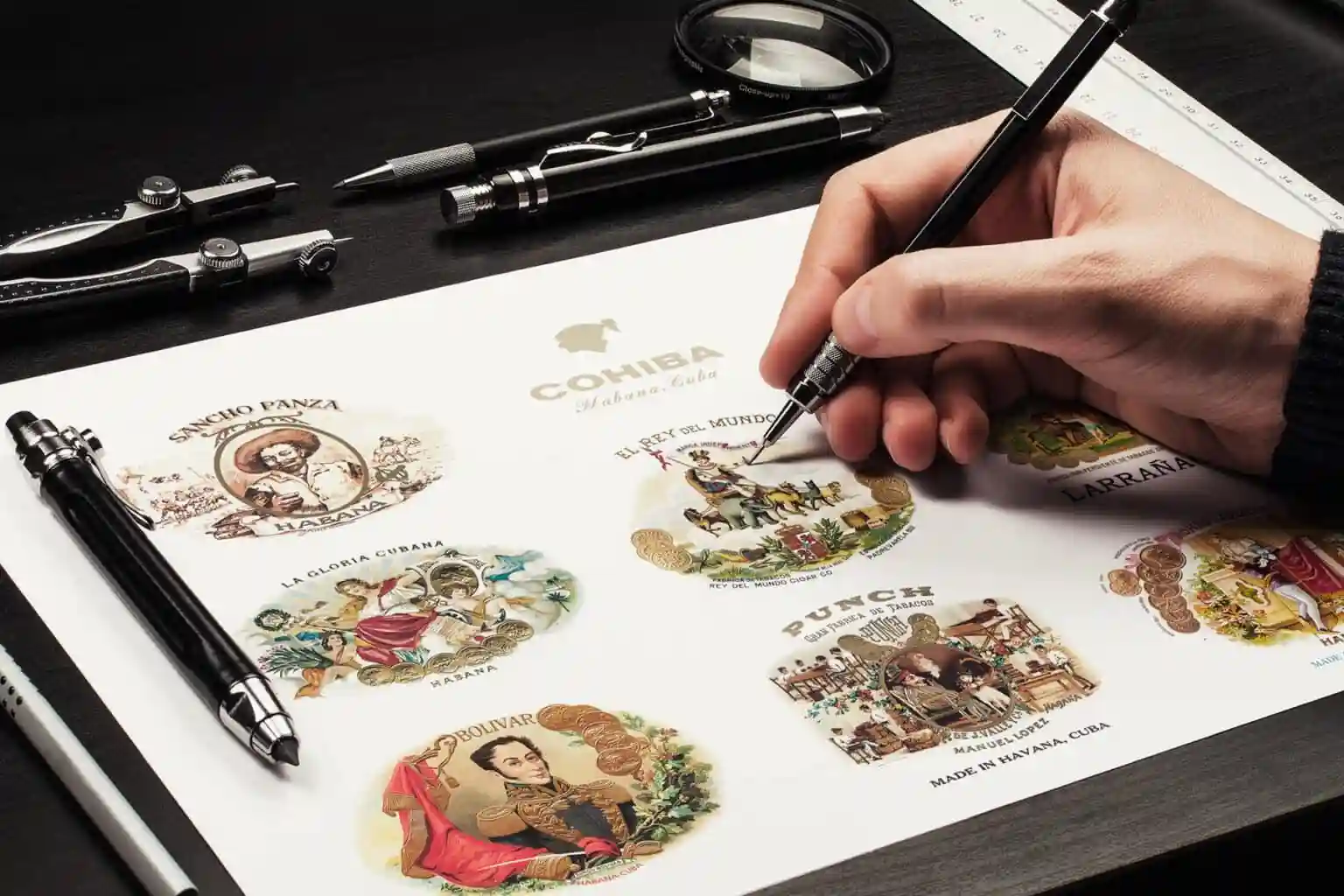
雪茄制造商的徽标就像皇家印章一样,能让人迅速识别雪茄的真伪。在雪茄盒和雪茄带上清晰可见的标识保证了雪茄的真实性,并将一支雪茄与另一支雪茄区分开来。但是,这些标识能揭示雪茄制造商的哪些信息,它们有什么特殊意义吗?
高希霸
高希霸标志无疑是哈瓦那爱好者最熟悉的标志之一。它代表着塔伊诺部落酋长的头像、 哈杜伊他因在 16 世纪反抗征服者的起义中扮演的角色而闻名。他被认为是新大陆第一个反抗殖民主义的酋长,今天在古巴仍被视为该国的第一位民族英雄。
选择这个符号代表 高希霸 并非毫无意义。它由菲德尔-卡斯特罗于 1966 年正式发起,呼应了古巴共产党自 1959 年革命结束以来开展的反帝斗争。
潘趣
潘趣雪茄由德国商人斯托克曼先生于 1840 年创立,是世界上历史最悠久的雪茄品牌之一。Habanos S.A. 该产品最初面向英国市场,其名称灵感来自于当时一个著名的讽刺人物、 潘趣先生.这与 潘趣先生 位于品牌最初标识的中心。徽标周围还有四个图标,分别代表雪茄生产的各个阶段,从烟叶运抵工厂到雪茄装箱。
罗密欧与朱丽叶
"(《世界人权宣言》) 罗密欧与朱丽叶雪茄品牌 代表莎士比亚悲剧《维罗纳的情人》中著名的阳台场景。选择这个 徽标与品牌名称一样,它的灵感也来自哈瓦那圣拉斐尔街工厂员工最喜爱的小说。从 19 世纪末开始,雪茄工厂就开始了读书活动,以教育和娱乐员工。当 Inocencio Álvarez Rodríguez 和 José Manin 买下这家工厂时,他们决定用员工们最喜欢的小说来命名工厂,以此向他们致敬。
Por Larrañaga
"(《世界人权宣言》) Por Larrañaga 描绘的是希腊女神赛卑尔在她的两头狮子阿塔兰塔和希波梅内斯的陪伴下的形象。在希腊神话中、 Cybèle 是众神之母,是大自然野性和植物力量的化身。因此,她被认为是生育女神之一。圣像中的五个孩子代表五大洲。此外,还可以看到制造商在国际博览会和展览会上获得的 20 块金牌。
伊格纳西奥-拉腊尼亚加选择这个标志的原因不得而知。不过,我们可以想象这是为了向大自然致敬,没有大自然就没有雪茄。伊格纳西奥-拉腊尼亚加是土生土长的西班牙人,他的灵感可能还来自于马德里市中心赛卑尔广场上的赛卑尔喷泉。
蒙特克里斯托
就像罗密欧与朱丽叶品牌一样、 蒙特克里斯托品牌 它的名字来自梅嫩德斯工厂工人最喜爱的小说。这就是著名的 基督山伯爵 大仲马的作品。因此,其徽标自然也受到了这部作品的启发。它描绘了 19 世纪初决斗时使用的六把剑和象征皇室的百合花,百合花代表蒙特克里斯托伯爵。
La Gloria Cubana
雪茄品牌标志 La Gloria Cubana 它融合了希腊罗马的象征意义和从土著文化中借鉴的图像。它描绘了罗马的和平女神,周围围绕着一个手持烟叶的印第安人和一个手持赫尔墨斯的仙人掌和镐的孩子。圣像还描绘了一面金盾,上面镌刻着众神使者赫尔墨斯的肖像。图像底部是制造商在国际展览会上获得的 6 枚金牌。
与品牌名称一样,该徽标也旨在颂扬古巴。它向古巴的美丽以及古巴人民的技能和决心致敬。
玻利瓦尔
的徽标 玻利瓦尔雪茄 向西蒙-玻利瓦尔将军(1783-1830 年)致敬。昵称 El Libertador这位政治和军事人物在委内瑞拉、玻利维亚和秘鲁等多个拉丁美洲国家的独立过程中发挥了决定性作用。作为南美反殖民斗争的关键人物,他现在被视为世界历史上的核心人物。
世界之王
徽标 世界之王 这幅画描绘了一个坐在金色宝座上的原住民,他由五种动物牵引:马、大象、骆驼、骡子和公羊。根据不同的解释,这些动物可能代表五大洲,或者更简单地说,代表人类最信赖的动物。该男子右手持矛,左手持雪茄。长矛末端飘扬着一条丝带,上面刻有""字样。 MARCA INDIDENTE ".图标中央是西班牙王室的徽章,周围是雪茄工厂常见的物品。在图标的两侧还可以看到雪茄制造商获得的六枚金牌。
正如 "El Rey del Mundo"(意为 "世界之王")这一名称一样,该品牌的标志也反映了安东尼奥-阿隆内斯将其公司打造成最高工艺代表之一的雄心壮志。 古巴.这位古巴人体现了古巴的伟大,他的王座则说明了古巴从西班牙王室中独立出来的事实。
桑丘-潘沙
与罗密欧与朱丽叶(Romeo Y Julieta)和蒙特克里斯托(Montecristo)一样,该品牌的 Sancho Panza 雪茄 的名字取自一部文学名著。在这里,它不是作品的名字,而是其中一个人物的名字。在讽刺小说《堂吉诃德》中,桑丘-潘沙是堂吉诃德忠实的侍从和冒险伙伴。 聪明的伊达尔戈-唐吉诃德-德拉曼恰 米格尔-德-塞万提斯的作品。不过,不知道选择这个人物来体现古巴品牌,是为了向哈瓦那安赫莱斯大街工厂的焊工们最喜欢的小说致敬,还是品牌创始人 Don Emilio Ohmstedt 特别欣赏这个人物。

雪茄製造商的徽標就像皇家印章一樣,能讓人迅速識別雪茄的真偽。 在雪茄盒和雪茄帶上清晰可見的標識保證了雪茄的真實性,並將一支雪茄與另一支雪茄區分開來。 但是,這些標識能揭示雪茄製造商的哪些資訊,它們有什麼特殊意義嗎?
高希霸
高希霸標誌無疑是哈瓦那愛好者最熟悉的標誌之一。 它代表著塔伊諾部落酋長的頭像、哈杜伊他因在16世紀反抗征服者的起義中扮演的角色而聞名。 他被認為是新大陸第一個反抗殖民主義的酋長,今天在古巴仍被視為該國的第一位民族英雄。
選擇這個符號代表高希霸並非毫無意義。 它由菲德爾-卡斯楚於1966年正式發起,呼應了古巴共產黨自1959年革命結束以來開展的反帝鬥爭。
潘趣
潘趣雪茄由德國商人斯托克曼先生於1840年創立,是世界上歷史最悠久的雪茄品牌之一。 Habanos S.A.該產品最初面向英國市場,其名稱靈感來自於當時一個著名的諷刺人物、潘趣先生. 這與潘趣先生位於品牌最初標識的中心。 徽標周圍還有四個圖標,分別代表雪茄生產的各個階段,從煙葉運抵工廠到雪茄裝箱。
羅密歐與茱麗葉
“(《世界人權宣言》)羅密歐與茱麗葉雪茄品牌代表莎士比亞悲劇《維羅納的情人》中著名的陽臺場景。選擇這個徽標與品牌名稱一樣,它的靈感也來自哈瓦那聖拉菲爾街工廠員工最喜愛的小說。從19世紀末開始,雪茄工廠就開始了讀書活動,以教育和娛樂員工。當InocencioÁlvarez Rodríguez和JoséManin買下這家工廠時,他們决定用員工們最喜歡的小說來命名工廠,以此向他們致敬。
Por Larrañaga
“(《世界人權宣言》)Por Larrañaga描繪的是希臘女神賽卑爾在她的兩頭獅子阿塔蘭塔和希波梅內斯的陪伴下的形象。 在希臘神話中、Cybèle是眾神之母,是大自然野性和植物力量的化身。 囙此,她被認為是生育女神之一。 聖像中的五個孩子代表五大洲。 此外,還可以看到製造商在國際博覽會和展覽會上獲得的20塊金牌。
伊格納西奧-拉臘尼亞加選擇這個標誌的原因不得而知。 不過,我們可以想像這是為了向大自然致敬,沒有大自然就沒有雪茄。 伊格納西奧-拉臘尼亞加是土生土長的西班牙人,他的靈感可能還來自於馬德里市中心賽卑爾廣場上的賽卑爾噴泉。
蒙特克裡斯托
就像羅密歐與茱麗葉品牌一樣、蒙特克裡斯托品牌它的名字來自梅嫩德斯工廠工人最喜愛的小說。 這就是著名的基督山伯爵大仲馬的作品。 囙此,其徽標自然也受到了這部作品的啟發。 它描繪了19世紀初決鬥時使用的六把劍和象徵皇室的百合花,百合花代表蒙特克裡斯托伯爵。
La Gloria Cubana
雪茄品牌標誌La Gloria Cubana它融合了希臘羅馬的象徵意義和從土著文化中借鑒的影像。 它描繪了羅馬的和平女神,周圍圍繞著一個手持煙葉的印第安人和一個手持赫爾墨斯的仙人掌和鎬的孩子。 聖像還描繪了一面金盾,上面鐫刻著眾神使者赫爾墨斯的肖像。 影像底部是製造商在國際展覽會上獲得的6枚金牌。
與品牌名稱一樣,該徽標也旨在頌揚古巴。 它向古巴的美麗以及古巴人民的技能和决心致敬。
玻利瓦爾省
的徽標玻利瓦爾省雪茄向西蒙-玻利瓦爾省將軍(1783-1830年)致敬。 昵稱El Libertador這位政治和軍事人物在委內瑞拉、玻利維亞和秘魯等多個拉丁美洲國家的獨立過程中發揮了决定性作用。 作為南美反殖民鬥爭的關鍵人物,他現在被視為世界歷史上的覈心人物。
世界之王
徽標世界之王這幅畫描繪了一個坐在金色寶座上的高山族,他由五種動物牽引:馬、大象、駱駝、騾子和公羊。 根據不同的解釋,這些動物可能代表五大洲,或者更簡單地說,代表人類最信賴的動物。 該男子右手持矛,左手持雪茄。 長矛末端飄揚著一條絲帶,上面刻有“”字樣。 MARCA INDIDENTE“.圖標中央是西班牙王室的徽章,周圍是雪茄工廠常見的物品。 在圖標的兩側還可以看到雪茄製造商獲得的六枚金牌。
正如“El Rey del Mundo”(意為“世界之王”)這一名稱一樣,該品牌的標誌也反映了安東尼奧-阿隆內斯將其公司打造成最高工藝代表之一的雄心壯志。 古巴. 這位古巴人體現了古巴的偉大,他的王座則說明了古巴從西班牙王室中獨立出來的事實。
桑丘-潘沙
與羅密歐與茱麗葉(Romeo Y Julieta)和蒙特克裡斯托(Montecristo)一樣,該品牌的Sancho Panza雪茄的名字取自一部文學名著。 在這裡,它不是作品的名字,而是其中一個人物的名字。 在諷刺小說《堂吉訶德》中,桑丘-潘沙是堂吉訶德忠實的侍從和冒險夥伴。 聰明的伊達爾戈-唐吉訶德-德拉曼恰米格爾-德-賽凡提斯的作品。 不過,不知道選擇這個人物來體現古巴品牌,是為了向哈瓦那安赫萊斯大街工廠的焊工們最喜歡的小說致敬,還是品牌創始人Don Emilio Ohmstedt特別欣賞這個人物。
 The cigar maker's logo acts like a royal seal and allows for quick identification of the cigar's authenticity. The clearly visible logo on the humidor and cigar band guarantees the authenticity of the cigar and distinguishes one cigar from another. But what do these logos reveal about cigar manufacturers, and do they have any special significance?
The cigar maker's logo acts like a royal seal and allows for quick identification of the cigar's authenticity. The clearly visible logo on the humidor and cigar band guarantees the authenticity of the cigar and distinguishes one cigar from another. But what do these logos reveal about cigar manufacturers, and do they have any special significance?
Cohiba
The Cohiba logo is undoubtedly one of the most familiar to Havana lovers. It represents the head of the Taino tribal chieftain, Haduyi, who is famous for his role in the 16th-century uprising against the conquerors. He is considered the first chieftain in the New World to rebel against colonialism and is still regarded today in Cuba as the country's first national hero.
The choice of this symbol to represent Cohiba is not for nothing. Officially launched by Fidel Castro in 1966, it echoes the anti-imperialist struggle waged by the Communist Party of Cuba since the end of the 1959 revolution.
Punch
Founded in 1840 by German businessman Mr. Stockman, Punch Cigars is one of the oldest cigar brands in the world. Originally intended for the British market, the Habanos S.A. product was named after a well-known satirical figure of the time, Mr. Punch. This is the same as Mr. Punch at the centre of the brand's original identity. There are also four icons around the logo, representing the various stages of cigar production, from the arrival of the tobacco leaves at the factory to the packing of the cigars.
Romeo and Juliet
(Universal Declaration of Human Rights) Romeo and Juliet cigar brand represents the famous balcony scene from Shakespeare's tragedy The Lover of Verona. Choosing this logo, like the brand name, it's also inspired by the favorite novel of the employees of the San Rafael Street factory in Havana. From the end of the 19th century, cigar factories began to read books to educate and entertain their employees. When Inocencio Álvarez Rodríguez and José Manin bought the factory, they decided to pay tribute to the employees by naming it after their favorite novel.
Por Larrañaga
(Universal Declaration of Human Rights) Por Larrañaga depicts the Greek goddess Sebele in the company of her two lions, Atalanta and Hippomenes. In Greek mythology, Cybèle is the mother of the gods, the embodiment of nature's wildness and the power of plants. As a result, she is considered one of the goddesses of fertility. The five children in the icon represent the five continents. In addition, the 20 gold medals won by the manufacturer at international fairs and exhibitions can be seen.
The reason why Ignacio Laraniaga chose this sign is unknown. Still, we can imagine that this is a tribute to nature, without which there would be no cigar. Ignacio Raragniaga is a native of Spain, and he may also have been inspired by the Sebere Fountain in Plaza de la Sebere in the heart of Madrid.
Montecristo
Just like Romeo & Juliet, Montecristo takes its name from the Menendez factory worker's favourite novel. This is the famous Count of Monte Cristo of Alexandre Dumas. So, naturally, its logo was also inspired by this work. It depicts six swords used in duels in the early 19th century and lilies symbolizing royalty, with lilies representing the Count of Montecristo.
La Gloria Cubana
The cigar brand logo La Gloria Cubana it blends Greco-Roman symbolism with images borrowed from indigenous cultures. It depicts the Roman goddess of peace, surrounded by an Indian holding a tobacco leaf and a child holding a cactus and pickaxe from Hermes. The icon also depicts a golden shield with an image of Hermes, the messenger of the gods. At the bottom of the image are 6 gold medals won by the manufacturer at international exhibitions.
Like the brand name, the logo is also intended to celebrate Cuba. It pays tribute to the beauty of Cuba and to the skill and determination of the Cuban people.
Bolívar
The logo of the Bolívar Cigar pays homage to General Simón Bolívar (1783-1830). Nicknamed El Libertador, this political and military figure played a decisive role in the independence process of several Latin American countries, including Venezuela, Bolivia and Peru. A key figure in South America's anti-colonial struggle, he is now regarded as a central figure in world history.
The King of the World
The painting 'King of the World' depicts a high mountain tribe sitting on a golden throne, pulled by five animals: horses, elephants, camels, mules, and rams. According to different interpretations, these animals may represent the five continents, or more simply, the animals that humans trust the most. The man holds a spear in his right hand and a cigar in his left hand. A ribbon fluttered at the end of the spear, with the words "" engraved on it. MARCA INDIDENTE ". The emblem of the Spanish royal family is located in the center of the icon, surrounded by common items from cigar factories. On both sides of the icon, six gold medals won by cigar manufacturers can also be seen.
Just like the name "El Rey del Mundo" (meaning "King of the World"), the brand's logo also reflects Antonio Aronnes' ambition to build his company into one of the highest representatives of craftsmanship. Cuba This Cuban embodies the greatness of Cuba, and his throne illustrates the fact that Cuba gained independence from the Spanish royal family.
Sangqiu Pansha
Like Romeo Y Julieta and Montecristo, the brand's Sancho Panza cigar is named after a literary masterpiece. Here, it is not the name of the work, but the name of one of the characters. In the satirical novel Don Quixote, Sancho Panza is a loyal attendant and adventure companion of Don Quixote. The works of the clever Hidalgo Don Quixote de la Mancha Miguel de Cervantes. However, it is unclear whether this character was chosen to showcase the Cuban brand as a tribute to the favorite novel of the welders at the Anhales Street factory in Havana, or whether the brand founder Don Emilio Ohmstedt particularly admires this character.




